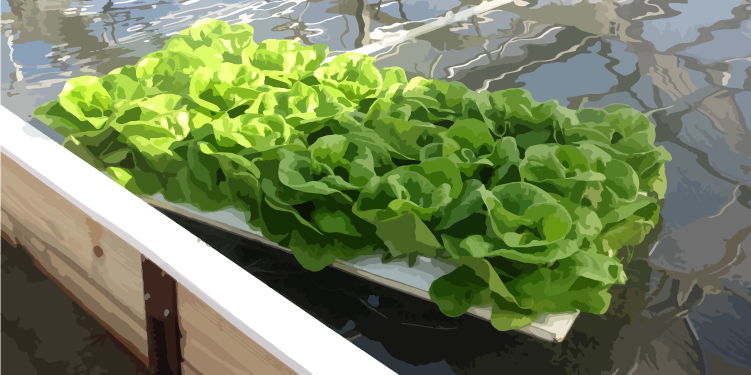Hydroponics is the growing of plants for food without soil as a growing medium. As changing climate and human development patterns erodes areas of topsoil, the ability to grow plants in mediums with liquid misting and fluid delivery of nutrients offers a sustainable alternative to current chemically fertilized and pesticide industrialized farming systems. The immediacy of the irrigation system decreases evaporation with direct contact with the plant’s root systems. It also mediates one of the problems with soil based plants - over or under watering as unnecessary water is drained away, recirculated, and aerated with fresh supplies of oxygen to the plant in the next cycle. Hydroponics uses 70% less water than conventional farming. Hydroponics farming is not seasonally based and produces plants 24 hours a day year round. In a closed system, terrestrial plants are grown with roots exposed to a nutrient-rich flow of water or settled into a medium such as gravel or perlite. Nutrients in the water come from a variety of natural waste sources like fish or ducks. Canada grows tomatoes, cucumbers, and peppers year-round in hydroponic greenhouses. Aeroponics is a second type of hydroponics system for growing plants without a growing medium that uses direct root misting. It is of great interest to NASA as it shifts from fluorescent grow lights, to less heat producing LED bulbs with a different color range. Hydroponic greenhouses produce faster harvest as their artificial lights shine 24 hours a day every day!

Activity 1 – Growing Plants in Static Water

Passive hydroponics consists of plants growing in freestanding glass or plastic containers at home in sunny windows. It helps to cover the top and sides of glass containers with foil or dark paper to stop light from creating algae in the standing water. Use everyday sunshine and water to grow food indoors inexpensively!
Activity 2 – Growing Plants in Continuous Flow

Plants growing in moving water require a pump and a wicking surface of the foam to keep the plants at the right level This system is used best for growing multiple plants. Many are set on a timer to clean the roots of accumulated salts, replace nutrients, and then aerate with oxygen. Active systems also use indoor grow lights. These are either fluorescent tubes or LED lamps. Fluorescent tubes give off heat whereas LED is temperature free. Draw an active hydroponics system and label all of the parts.
Activity 3 – Growing Mediums

Hydroponics uses different growing mediums. They include coconut fibers, rock wool, coco chips, perlite, vermiculite, clay pellets, and gravel. How do you choose? Make a chart of the availability and costs of each material. Does the medium exist around your house? Do you have to order it in the mail? Experiment with different growing mediums and see which ones work best for you.
Activity 4 – Nutrients

Hydroponic plants need nutrients to grow. What do you think they need? What makes a plant healthy? Research what hydroponic plants need. Look at Simply Hydroponics and Organics and make a poster of essentials and note what each ingredient delivers. Note how deficiencies of necessary nutrients reveal and damage production of healthy plants.
Activity 5 – Benefits of Hydroponic Farming

Hydroponics has many benefits. First of all, it doesn’t use precious soil. The amount of fertile topsoil is rapidly disappearing in the world. Without the need for soil, it distances itself from insects and diseases, reducing the reliance on pesticide and fertilization to keep the field fertile. Lit twenty-four hours a day, crops grow and mature more quickly. With vertical hydroponics, we can achieve raised crop yields. And most of all, it saves water! Make a poster sharing the advantages of hydroponic farming!
Review
- What is one primary advantage of hydroponic farming compared to conventional farming?
- Why is it recommended to cover the sides and top of glass containers used in passive hydroponics?
- In a continuous flow hydroponic system, what is the purpose of the pump and wicking surface?
- Which of the following is a commonly used hydroponic growing medium?
- What is a primary purpose of nutrients in a hydroponic system?
- Which of the following is a benefit of hydroponic farming?



















































